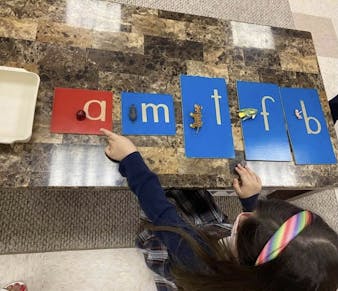Preschool & Kindergarten
The Preschool & Kindergarten Program

Overview
The Montessori Primary classroom is a prepared environment based on Maria Montessori's first plane of development. In this environment the children are comfortable and feel at home. Everything within this environment is designed to specifically to meet the needs of the young child. As Dr. Montessori observed, young children’s learning is almost effortless as they explore, manipulate and internalize their environment. Our teachers observe the children carefully and note the individuality of all children incorporating engaging materials and activities into the environment. This environment encourages a natural progression through different sensitive periods, or times when children are most ready to learn particular skills.
The Preschool / Kindergarten environments always -
* Show respect for the child as a unique, capable, and independent being
*Allow for freedom of choice so children can select work independently
* Provide order and structure reflective of children’s innate needs and tendency toward logical progression
* Allow the children to observe, care for and connect with nature
* Provide aesthetically pleasing neat and orderly materials to capture the interest of children
* Have Montessori materials that are attractive, age and developmentally appropriate, self-correcting and providing of both a direct and indirect aim as well as a sequence from the concrete to the abstract.
Within the Montessori framework, our orderly preschool environment is organized into five integrated curriculum areas: Practical Life, Sensorial, Language, Mathematics and Cultural(including Science and Geography). Music and Art are included as part of the Practical Life curriculum on a daily basis. The prepared environments provide much opportunity for both fine and gross motor development and flow within orderly guidelines.
The multi-age setting benefits all children in that older children model appropriate behavior and empathy for younger ones. The younger children benefit by observing the leadership and learning choices of the older children and aspire to follow their lead. Children learn to treat others as they would like to be treated, to respect all living and non-living things, to care for their environments, and to resolve conflicts using words rather than actions.
The Preschool & Kindergarten days begin at 8:00AM with morning circle. Then the students go into their morning work cycle where they are given lessons and independent work. During this morning work time there is a snack break. Lunch/playtime is an hour, then the younger students have rest time while the Kindergarten students are taken for "Special Lessons". After rest time the afternoon work cycle begins. They day ends at 3:00 for preschool and kindergarten students.
Program Events
Upcoming events to be posted here. Keep an eye out throughout the school year.
Curriculum
The Early Childhood level, for children ages 2.9 – 6, encourages preschoolers to explore and discover, to collaborate with classmates, and to take ownership of their education. The Montessori Method encourages self-directed learning that promotes self-confidence, independent thought and action, and critical thinking, while fostering social-emotional and intellectual growth.
Education for peace is a foundational component of Montessori education at all levels. At the Early Childhood level, the teaching of peace, social justice, and global citizenship is based on fostering respect for all people and living things, and helping children learn the tools for peaceful conflict resolution.
A Montessori Early Childhood classroom feels more like a home than a school. You won’t see desks, nor will a teacher stand at the front of the room delivering a lesson to the whole class. Instead, you’ll see children happily working individually or in small groups, at tables or on the floor near small mats that delineate their own space.
Specially designed learning materials are displayed on open shelves, easily accessible to the children. Classrooms also include child-sized furniture, cozy spaces for quiet reading, reachable shelves with work available for free choice. Teachers gently guide students to help maintain the organization and cleanliness of this environment to keep it orderly and attractive, and to help your child understand how to care for materials and clean up after themselves. These skills may even carry over in your home.
During the first 2 years in an Early Childhood classroom, Montessori students look forward to their turn to be a leader. In their third year—often known as Kindergarten—children get their turn and take pride in being the oldest. They serve as role models for younger students; they demonstrate leadership and citizenship skills. They reinforce and consolidate their own learning by teaching concepts they have already mastered to their peers. In their Kindergarten year, they express confidence, develop self-esteem and self-sufficiency, and show responsibility.
Kindergarteners are introduced to progressively more advanced Montessori materials and sophisticated, fascinating lessons. And they experience an important period in which their previous learning from working with concrete Montessori materials begins to become permanent knowledge. A Montessori Kindergarten student sees and feels their personal growth as they watch others learn information they have mastered themselves.
Kindergarten is the culmination of the Early Childhood program. Children exhibit the independence, critical thinking, collaboration, and leadership that they have been practicing during their previous years in the Early Childhood classroom, exercising them independently as they prepare to transition into the lower elementary program.
